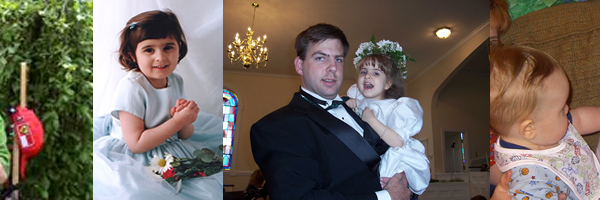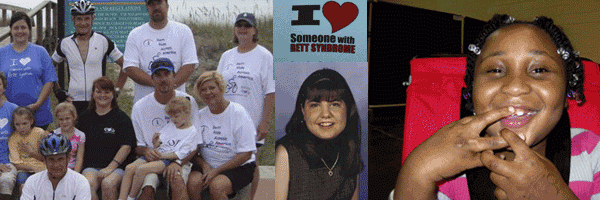



About Rett Syndrome
Rett syndrome is a disorder of the nervous system that leads to developmental reversals, especially in the areas of expressive language and hand use.
Causes, incidence, and risk factors
Rett syndrome occurs almost exclusively in girls and may be misdiagnosed as autism or cerebral palsy. Studies have linked many Rett syndrome cases to a defect in the methl-CpG-binding protein 2 (MeCP2) gene. This gene is on the X chromosome. Females have two X chromosomes, so even when one has this significant defect, the other X chromosome is normal enough for the child to survive. Males born with this defective gene do not have a second X chromosome to make up for the problem. Therefore, the defect usually results in miscarriage, stillbirth, or very early death. The condition affects about 1 out of 10,000 children. Groups of the disease have appeared within families and certain geographic regions, including Norway, Sweden, and northern Italy.
Symptoms
An infant with Rett syndrome usually has normal development for the first 6 – 18 months. Symptoms range from mild to severe. Symptoms may include:
- Apraxia
- Breathing problems — problems tend to get worse with stress; breathing is usually normal during sleep and abnormal while awake
- Change in development
- Excessive saliva and drooling
- Floppy arms and legs — frequently the first sign
- Intellectual disabilities and learning difficulties (assessing cognitive skills in those with Rett syndrome, however, is difficult because of the speech and hand motion abnormalities)
- Scoliosis
- Shaky, unsteady, or stiff gait; or toe walking
- Seizures
- Slowing head growth beginning at approximately 5 – 6 months of age
- Loss of normal sleep patterns
- Loss of purposeful hand movements; for example, the grasp used to pick up small objects is replaced by repetitive hand motions like hand wringing or constant placement of hands in mouth
- Loss of social engagement
- Ongoing, severe constipation and gastroesophageal reflux (GERD)
- Poor circulation that can lead to cold and bluish arms and legs
- Severe language development problems
NOTE: Problems in breathing pattern may be the most upsetting and difficult symptom for parents to watch. Why they happen and what to do about them is not well understood. Most experts in Rett syndrome recommend that parents remain calm through an episode of irregular breathing like breath holding. It may help to remind yourself that normal breathing always returns and that your child will become used to the abnormal breathing pattern.
Signs and tests
Genetic testing may be done to look for the gene defect associated with the syndrome. However, since the defect is not identified in everyone with the disease, the diagnosis of Rett syndrome is based on symptoms. There are several different types of Rett syndrome:
- Atypical
- Classical (meets the diagnostic criteria)
- Provisional (some symptoms appear between ages 1 and 3)
Rett syndrome is classified as atypical if:
- It begins early (soon after birth) or late (beyond 18 months of age, sometimes as late as 3 or 4 years old)
- Speech and hand skill problems are mild
- It is appears in a boy (very rare)
Treatment
Treatment may include:
- Assistance with feeding and diapering
- Methods to treat constipation and GERD
- Physical therapy to help prevent the hands from contracting
- Weight bearing exercises for those with scoliosis
Supplemental feedings can help those with slowed growth. A feeding tube may be needed if the patient breathes in (aspirates) food. Diets high in calories and fat, as well as nasogastric tube feeds, can help increase weight and height. Weight gain may improve alertness and social interactions. Medications such as carbamazepine may be used to treat seizures. Other medications or supplements that have been used or studied include:
- Bromocriptine
- Dextromethorphan
- Folate and betaine
- L-carnitine, which may help improve language skills, muscle mass, alertness, energy and quality of life while decreasing constipation and daytime sleepiness
- L-dopa for motor rigidity in later stages of the disease
Stem cell therapy, alone or in combination with gene therapy, is another hopeful treatment.
Support Groups
Southeastern Rett Syndrome Alliance – www.serett.org International Rett Syndrome Foundation – www.rettsyndrome.org
Expectations (prognosis)
The disease slowly progresses until the patient is a teenager. Then, symptoms may improve. For example, seizures or breathing problems tend to lessen in late adolescence. Developmental regression or delays vary. Usually, a child with Rett syndrome sits up properly but may not crawl. For those who do crawl, many do so by scooting on their tummy without using their hands. Similarly, some children walk independently within the normal age range, while others are delayed, don’t learn to walk independently at all, or don’t learn to walk until late childhood or early adolescence. For those children who do learn to walk at the normal time, some keep that ability for their lifetime, while other children lose the skill. Life expectancies are not well studied, although survival at least until the mid-20s is likely. The average life expectancy of a girl with Rett syndrome may be mid-40s. Death is often related to seizure, aspiration pneumonia, malnutrition, and accidents.
Calling your health care provider
Call your health care provider if you have any concerns about your child’s development, if you notice a lack of normal development with motor or language skills in a child, or if there are associated disorders that need treatment.
Prevention
The likelihood of having another child with Rett syndrome is less than 1%.
Background on Rett Syndrome
Rett Syndrome, a neurological disorder named after Dr. Andreas Rett, who first described the condition, it occurs predominantly in girls.
The child with Rett syndrome usually shows an early period of normal or near-normal development until about 6 to 18 months of age.
A period of temporary stagnation or regression follows during which time the child loses communication skills and purposeful use of the hands. Soon, stereotyped hand movements, gait disturbances, and slowing of the rate of head growth become apparent.
Other problems encountered may include seizures and disorganized breathing patterns. Apraxia, the inability to program the body to perform motor movements, is the most fundamental and severely handicapping aspect of Rett. Rett is a developmental disorder rather than a degenerative disorder as once thought.
In 1999, it was discovered that Rett syndrome is caused by a mutation of the MECP2 gene on the X chromosome.
Now that the gene has been found, new efforts are underway to develop treatments and ultimately a cure, for Rett syndrome.
CONTACT US
Southeastern Rett Syndrome Alliance
7564 Windsong Dr
Trussville AL 35173-1898
Phone 1.205.661.9597
Email admin@serett.org
A non-profit 501(c)3
EIN 26-2023249